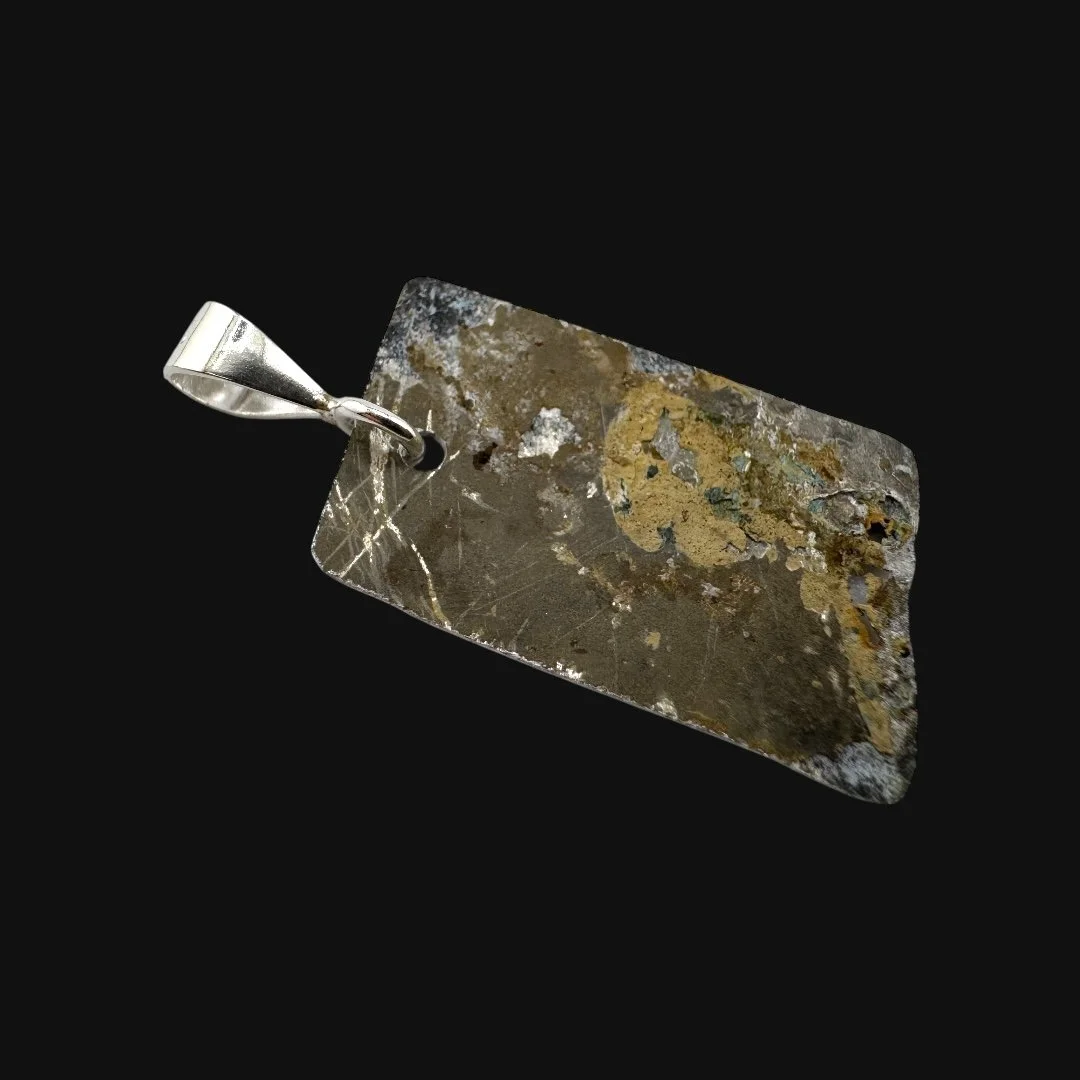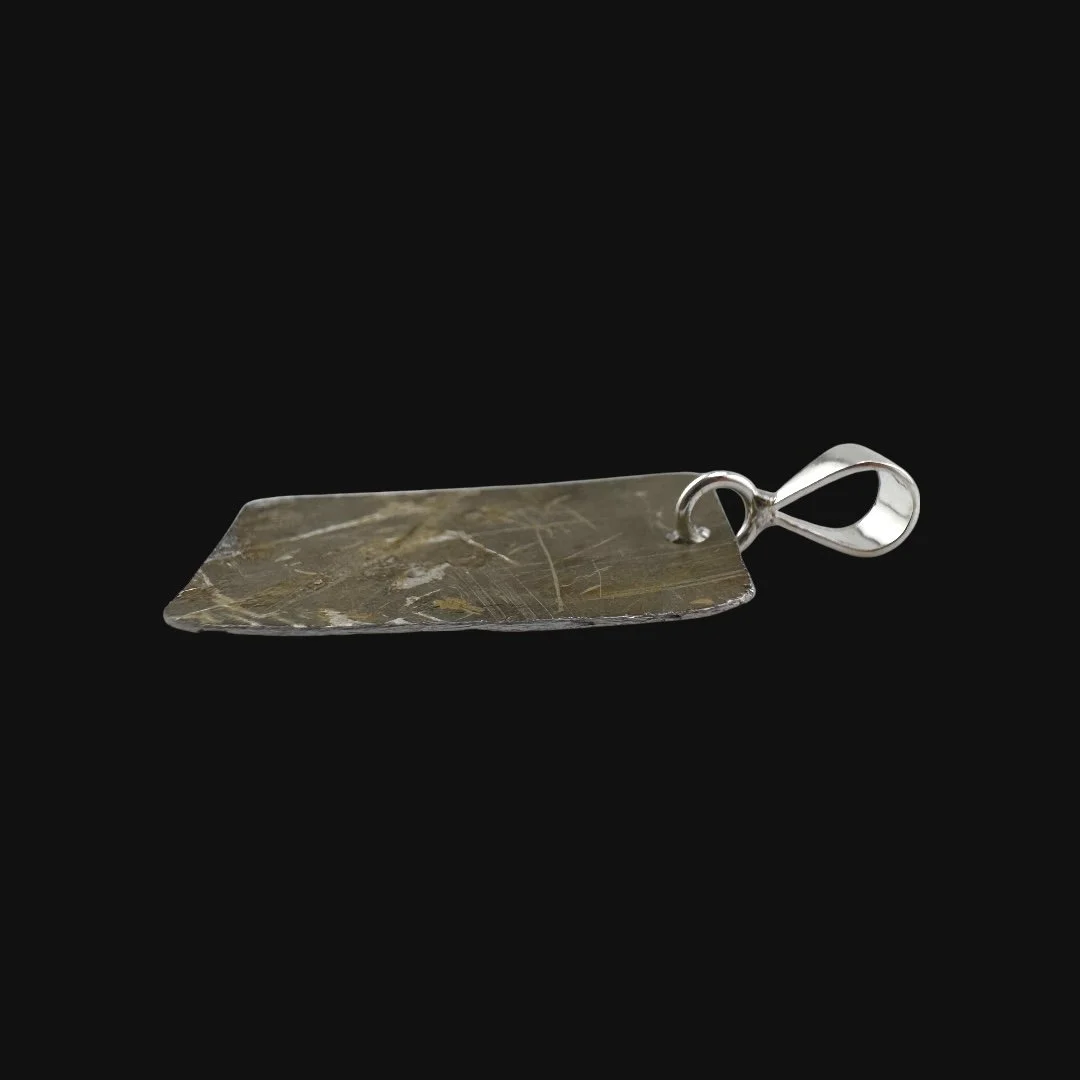 Image 1 of 13
Image 1 of 13

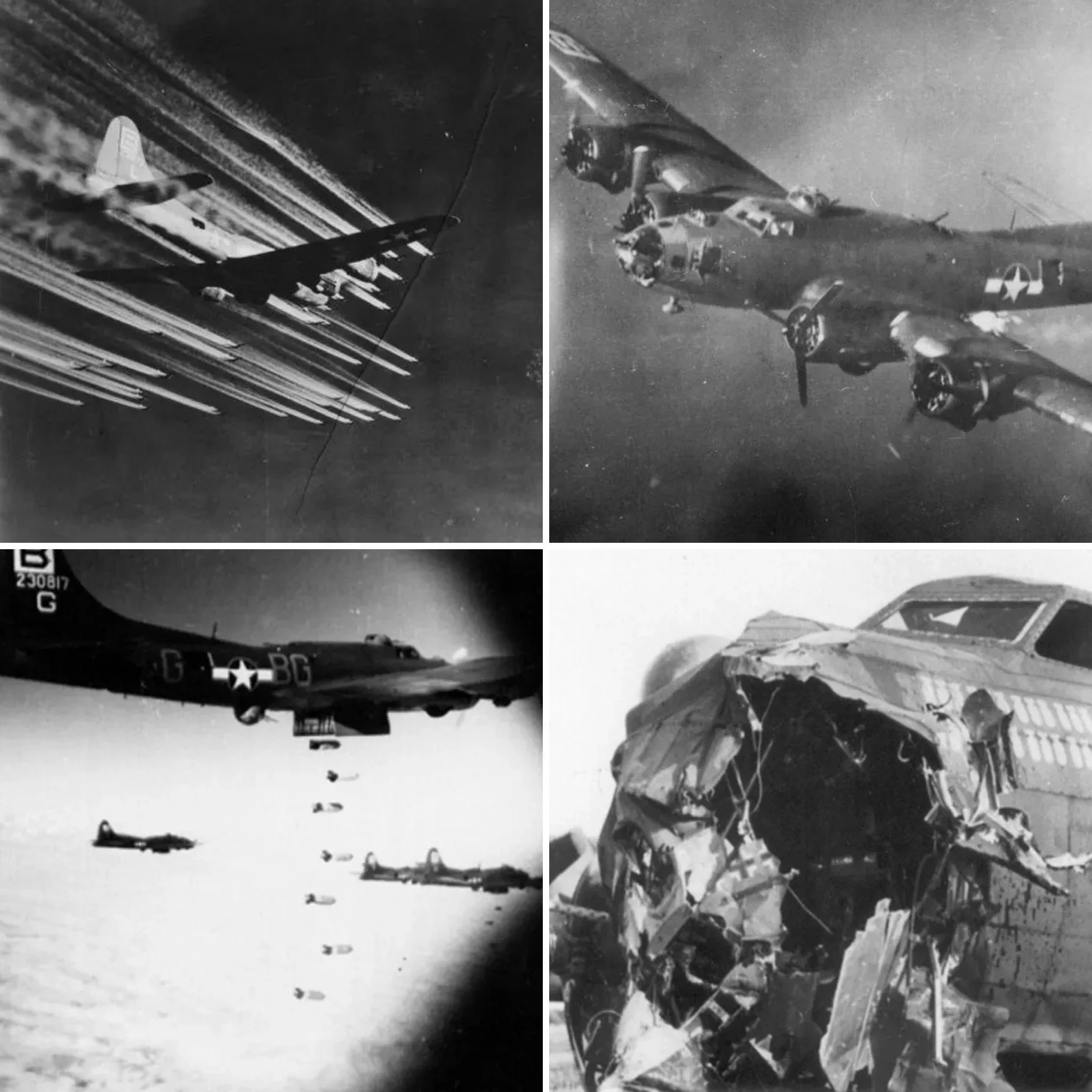 Image 2 of 13
Image 2 of 13

 Image 3 of 13
Image 3 of 13

 Image 4 of 13
Image 4 of 13

 Image 5 of 13
Image 5 of 13

 Image 6 of 13
Image 6 of 13

 Image 7 of 13
Image 7 of 13

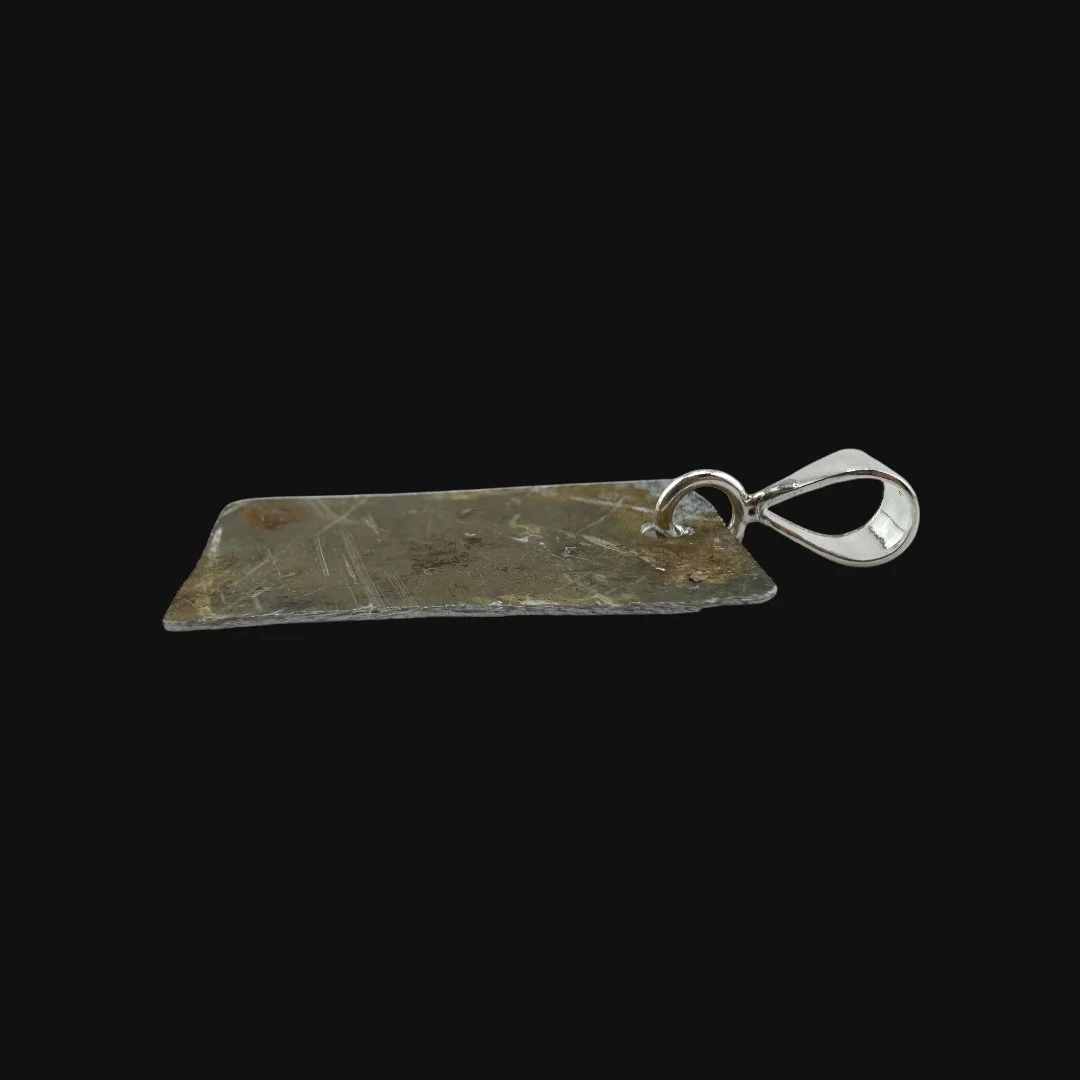 Image 8 of 13
Image 8 of 13

 Image 9 of 13
Image 9 of 13

 Image 10 of 13
Image 10 of 13

 Image 11 of 13
Image 11 of 13

 Image 12 of 13
Image 12 of 13

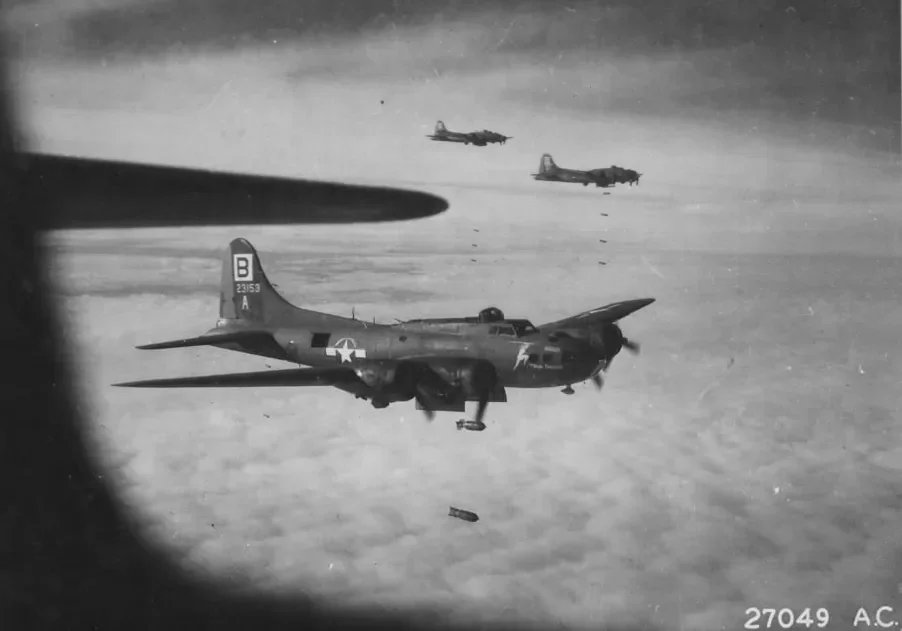 Image 13 of 13
Image 13 of 13














Original WWII 1944-1945 B-17 Flying Fortress 8th Air Force "Combat Flown" 95th Bomb Group Heavy Bomber Aircraft Metal Fragment Necklace Pendant (.925 Sterling Silver)
Comes with a hand-signed C.O.A. and a full historical research write-up
From: World War II
Dated: 1944-1945
Aircraft: Boeing B-17 Flying Fortress
Type: Heavy Bomber
From: European Theater “Combat Flown” U.S. Army Air Force (USAAF) 8th Air Force - 95th Bomb Group
National Origin: United States (American)
Necklace Pendant Size: Roughly 1 inch x ½ inch
Pendant Clap Material: .925 Sterling Silver
*EACH WORLD WAR II “COMBAT FLOWN” AIRCRAFT METAL PENDANT IS HANDMADE AND TRULY ONE-OF-A-KIND. THIS IS THE EXACT WWII AIRCRAFT NECKLACE PENDANT YOU WILL RECEIVE.
Wearable History Collection:
This World War II necklace aircraft pendant is more truly one-of-a-kind. It is a preserved piece of an original WWII aircraft, transformed into a wearable artifact that carries with it the stories of a generation. No two pendants are alike, which makes each one truly unique and irreplaceable. Rich with aviation history, this “combat flown” aircraft pendant offers its wearer the rare chance to carry a genuine fragment of World War II aviation heritage. Every mark in the metal, every detail, holds a connection to the past and serves as a tangible reminder of courage, sacrifice, and resilience. As part of our exclusive Wearable History Collection, it is not only a timeless accessory but also a powerful conversation starter. Flown in the heat of combat during World War II and preserved across generations, this WWII aircraft pendant is a relic unlike any other. Featured in our Wearable History Collection, it represents a rare chance to wear a true fragment of the past.
Strength and Sacrifice: The Legacy of the B-17 Flying Fortress:
The Boeing B-17 Flying Fortress was one of the most iconic and influential aircraft of the Second World War. Built for endurance and heavy defensive firepower, the B-17 was designed to withstand enemy attack and deliver precision bombing deep into enemy territory. With four powerful engines, a rugged frame, and up to thirteen machine guns, it embodied the name “Flying Fortress,” earning a reputation for bringing its crews home even when battered by flak and fighters.
When the United States entered the European air war, the B-17 became the backbone of the 8th Air Force, based in England. Daylight bombing campaigns carried American airpower directly over Nazi-occupied Europe, targeting industrial centers, oil refineries, and transportation hubs. Among the most distinguished units to fly the Fortress was the 95th Bomb Group, which pioneered long-range strategic missions and endured some of the fiercest opposition of the war.
Flying in massive combat box formations, the 95th and their sister groups faced relentless attacks from German fighters and the deadly curtain of flak that awaited them over cities like Regensburg, Schweinfurt, and Berlin. Losses were staggering, and missions often tested the resolve of even the most seasoned crews. Yet, the B-17’s durability and the determination of the men inside carried the campaign forward. Each successful strike weakened the German war machine, setting the stage for Allied ground offensives.
The B-17’s defining contribution came during the relentless air campaign of 1943 and 1944, when the 8th Air Force fought for air superiority over Europe. By the time of D-Day in June 1944, the skies were largely under Allied control, thanks in no small part to the sacrifices of B-17 crews. The 95th Bomb Group, flying from Horham, Suffolk, continued striking railways, bridges, and airfields, ensuring German forces could not disrupt the landings in Normandy.
Beyond its destructive power, the B-17 carried immense symbolic weight. To the Allies, it represented resilience and the promise of eventual victory. To civilians in occupied Europe, its contrails overhead signaled hope. And to German forces, the sight of a thousand-plane raid testified to the industrial might and determination of the United States.
In retrospect, the legacy of the B-17 is one of both heroism and sacrifice. It demonstrated the strategic value of precision bombing but also underscored the human cost of such campaigns. The 95th Bomb Group became a symbol of that struggle, its men flying mission after mission in the face of unimaginable danger. The Flying Fortress not only helped pave the road to victory in Europe but also secured its place as one of the most iconic aircraft of the twentieth century, remembered as much for the courage of its crews as for the strength of the machine itself.
The Flying Fortress in the European War:
Early Missions and Heavy Losses (1942–1943)
First Raids from England (1942) – The Boeing B-17 Flying Fortress began its European campaign with the 8th Air Force, flying out of bases in England. Designed for long-range precision bombing, it was tasked with striking deep into occupied Europe. Crews quickly learned that daylight raids came at a heavy cost, as formations were savaged by flak and German fighters.
The 95th Bomb Group Joins the Fight (1943) – Activated in 1942 and deployed to Horham, Suffolk, the 95th became one of the first groups to carry the burden of sustained strategic bombing. Their missions against U-boat pens, aircraft factories, and industrial targets proved both the potential and the peril of America’s daylight bombing strategy.
Forging a Strategy (1943–1944)
Regensburg and Schweinfurt (1943) – The 95th Bomb Group took part in the famed raids against German ball-bearing factories and aircraft plants. Losses were staggering, but these missions demonstrated American resolve and the B-17’s role as the workhorse of the 8th Air Force.
Building Air Superiority – Flying in tight defensive formations, the Fortresses unleashed destruction on the German war machine while absorbing punishment that would have downed lesser aircraft. Their endurance set the stage for long-term strategic bombing success once long-range escorts like the P-51 Mustang arrived.
D-Day and the Battle for Normandy (June 1944)
June 6, 1944 – On D-Day, B-17s of the 95th Bomb Group bombed coastal defenses, road networks, and communication hubs across northern France. Their mission was to isolate the battlefield, prevent reinforcements from reaching Normandy, and soften German resistance for the troops storming the beaches.
Sustained Operations Over France – In the weeks that followed, the group continued striking railways, bridges, and fortified positions behind enemy lines. Each mission supported the breakout from Normandy and the eventual liberation of Paris.
Driving the War Home (1944–1945)
The Strategic Bombing Offensive – As the Allies gained air superiority, the 95th Bomb Group and other units of the 8th Air Force shifted to crippling Germany’s industrial heartland. Oil refineries, rail yards, and manufacturing plants were relentlessly targeted, starving the Wehrmacht of fuel and weapons.
Battle of the Bulge (1944–1945) – Flying in brutal winter conditions, B-17s struck supply depots, troop concentrations, and transportation routes, aiding the defense of American lines during Germany’s last great counteroffensive.
Final Missions into Germany – In early 1945, the Fortresses continued bombing campaigns that destroyed bridges across the Rhine and shattered what remained of German infrastructure. Their missions paved the way for Allied forces to push into the heart of the Reich.
The Legacy Within This WWII Necklace Pendant:
This handcrafted World War II necklace pendant has been created from the very metal of a Boeing B-17 Flying Fortress, once flown in combat by the 8th Air Force’s 95th Bomb Group. The B-17 was the backbone of America’s daylight bombing campaign over Europe, a rugged and resilient aircraft that carried its crews deep into enemy territory. Flying from bases in England, the 95th Bomb Group braved waves of German fighters and deadly flak to strike at factories, railways, and fortifications that fueled the Nazi war machine.
Every mark in this metal carries echoes of those missions. It recalls the roar of four engines lifting into the cold morning skies over Suffolk. It remembers the black bursts of flak that dotted the horizon above Berlin, and the determination of the crews who held formation against impossible odds. Forged into a pendant, this fragment ceases to be just a remnant of a machine. It becomes a symbol of resilience, sacrifice, and the relentless fight that brought victory in Europe.
Each pendant is unique, a singular survivor of history. To wear it is to hold not just jewelry, but a piece of the air war over Europe. It invites conversation, sparks reflection, and connects the present to the courage of those who flew with the 95th Bomb Group. More than an accessory, this pendant is a living fragment of history. A remembrance of sacrifice. And a lasting tribute to the men and missions that helped carry the war to its end.
Comes with a hand-signed C.O.A. and a full historical research write-up
From: World War II
Dated: 1944-1945
Aircraft: Boeing B-17 Flying Fortress
Type: Heavy Bomber
From: European Theater “Combat Flown” U.S. Army Air Force (USAAF) 8th Air Force - 95th Bomb Group
National Origin: United States (American)
Necklace Pendant Size: Roughly 1 inch x ½ inch
Pendant Clap Material: .925 Sterling Silver
*EACH WORLD WAR II “COMBAT FLOWN” AIRCRAFT METAL PENDANT IS HANDMADE AND TRULY ONE-OF-A-KIND. THIS IS THE EXACT WWII AIRCRAFT NECKLACE PENDANT YOU WILL RECEIVE.
Wearable History Collection:
This World War II necklace aircraft pendant is more truly one-of-a-kind. It is a preserved piece of an original WWII aircraft, transformed into a wearable artifact that carries with it the stories of a generation. No two pendants are alike, which makes each one truly unique and irreplaceable. Rich with aviation history, this “combat flown” aircraft pendant offers its wearer the rare chance to carry a genuine fragment of World War II aviation heritage. Every mark in the metal, every detail, holds a connection to the past and serves as a tangible reminder of courage, sacrifice, and resilience. As part of our exclusive Wearable History Collection, it is not only a timeless accessory but also a powerful conversation starter. Flown in the heat of combat during World War II and preserved across generations, this WWII aircraft pendant is a relic unlike any other. Featured in our Wearable History Collection, it represents a rare chance to wear a true fragment of the past.
Strength and Sacrifice: The Legacy of the B-17 Flying Fortress:
The Boeing B-17 Flying Fortress was one of the most iconic and influential aircraft of the Second World War. Built for endurance and heavy defensive firepower, the B-17 was designed to withstand enemy attack and deliver precision bombing deep into enemy territory. With four powerful engines, a rugged frame, and up to thirteen machine guns, it embodied the name “Flying Fortress,” earning a reputation for bringing its crews home even when battered by flak and fighters.
When the United States entered the European air war, the B-17 became the backbone of the 8th Air Force, based in England. Daylight bombing campaigns carried American airpower directly over Nazi-occupied Europe, targeting industrial centers, oil refineries, and transportation hubs. Among the most distinguished units to fly the Fortress was the 95th Bomb Group, which pioneered long-range strategic missions and endured some of the fiercest opposition of the war.
Flying in massive combat box formations, the 95th and their sister groups faced relentless attacks from German fighters and the deadly curtain of flak that awaited them over cities like Regensburg, Schweinfurt, and Berlin. Losses were staggering, and missions often tested the resolve of even the most seasoned crews. Yet, the B-17’s durability and the determination of the men inside carried the campaign forward. Each successful strike weakened the German war machine, setting the stage for Allied ground offensives.
The B-17’s defining contribution came during the relentless air campaign of 1943 and 1944, when the 8th Air Force fought for air superiority over Europe. By the time of D-Day in June 1944, the skies were largely under Allied control, thanks in no small part to the sacrifices of B-17 crews. The 95th Bomb Group, flying from Horham, Suffolk, continued striking railways, bridges, and airfields, ensuring German forces could not disrupt the landings in Normandy.
Beyond its destructive power, the B-17 carried immense symbolic weight. To the Allies, it represented resilience and the promise of eventual victory. To civilians in occupied Europe, its contrails overhead signaled hope. And to German forces, the sight of a thousand-plane raid testified to the industrial might and determination of the United States.
In retrospect, the legacy of the B-17 is one of both heroism and sacrifice. It demonstrated the strategic value of precision bombing but also underscored the human cost of such campaigns. The 95th Bomb Group became a symbol of that struggle, its men flying mission after mission in the face of unimaginable danger. The Flying Fortress not only helped pave the road to victory in Europe but also secured its place as one of the most iconic aircraft of the twentieth century, remembered as much for the courage of its crews as for the strength of the machine itself.
The Flying Fortress in the European War:
Early Missions and Heavy Losses (1942–1943)
First Raids from England (1942) – The Boeing B-17 Flying Fortress began its European campaign with the 8th Air Force, flying out of bases in England. Designed for long-range precision bombing, it was tasked with striking deep into occupied Europe. Crews quickly learned that daylight raids came at a heavy cost, as formations were savaged by flak and German fighters.
The 95th Bomb Group Joins the Fight (1943) – Activated in 1942 and deployed to Horham, Suffolk, the 95th became one of the first groups to carry the burden of sustained strategic bombing. Their missions against U-boat pens, aircraft factories, and industrial targets proved both the potential and the peril of America’s daylight bombing strategy.
Forging a Strategy (1943–1944)
Regensburg and Schweinfurt (1943) – The 95th Bomb Group took part in the famed raids against German ball-bearing factories and aircraft plants. Losses were staggering, but these missions demonstrated American resolve and the B-17’s role as the workhorse of the 8th Air Force.
Building Air Superiority – Flying in tight defensive formations, the Fortresses unleashed destruction on the German war machine while absorbing punishment that would have downed lesser aircraft. Their endurance set the stage for long-term strategic bombing success once long-range escorts like the P-51 Mustang arrived.
D-Day and the Battle for Normandy (June 1944)
June 6, 1944 – On D-Day, B-17s of the 95th Bomb Group bombed coastal defenses, road networks, and communication hubs across northern France. Their mission was to isolate the battlefield, prevent reinforcements from reaching Normandy, and soften German resistance for the troops storming the beaches.
Sustained Operations Over France – In the weeks that followed, the group continued striking railways, bridges, and fortified positions behind enemy lines. Each mission supported the breakout from Normandy and the eventual liberation of Paris.
Driving the War Home (1944–1945)
The Strategic Bombing Offensive – As the Allies gained air superiority, the 95th Bomb Group and other units of the 8th Air Force shifted to crippling Germany’s industrial heartland. Oil refineries, rail yards, and manufacturing plants were relentlessly targeted, starving the Wehrmacht of fuel and weapons.
Battle of the Bulge (1944–1945) – Flying in brutal winter conditions, B-17s struck supply depots, troop concentrations, and transportation routes, aiding the defense of American lines during Germany’s last great counteroffensive.
Final Missions into Germany – In early 1945, the Fortresses continued bombing campaigns that destroyed bridges across the Rhine and shattered what remained of German infrastructure. Their missions paved the way for Allied forces to push into the heart of the Reich.
The Legacy Within This WWII Necklace Pendant:
This handcrafted World War II necklace pendant has been created from the very metal of a Boeing B-17 Flying Fortress, once flown in combat by the 8th Air Force’s 95th Bomb Group. The B-17 was the backbone of America’s daylight bombing campaign over Europe, a rugged and resilient aircraft that carried its crews deep into enemy territory. Flying from bases in England, the 95th Bomb Group braved waves of German fighters and deadly flak to strike at factories, railways, and fortifications that fueled the Nazi war machine.
Every mark in this metal carries echoes of those missions. It recalls the roar of four engines lifting into the cold morning skies over Suffolk. It remembers the black bursts of flak that dotted the horizon above Berlin, and the determination of the crews who held formation against impossible odds. Forged into a pendant, this fragment ceases to be just a remnant of a machine. It becomes a symbol of resilience, sacrifice, and the relentless fight that brought victory in Europe.
Each pendant is unique, a singular survivor of history. To wear it is to hold not just jewelry, but a piece of the air war over Europe. It invites conversation, sparks reflection, and connects the present to the courage of those who flew with the 95th Bomb Group. More than an accessory, this pendant is a living fragment of history. A remembrance of sacrifice. And a lasting tribute to the men and missions that helped carry the war to its end.





